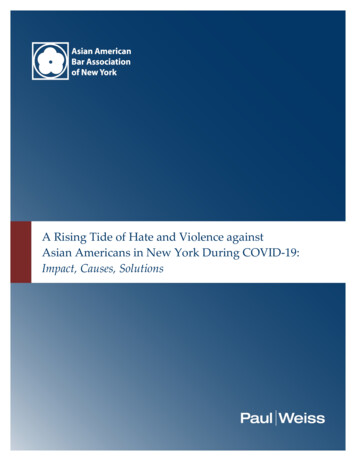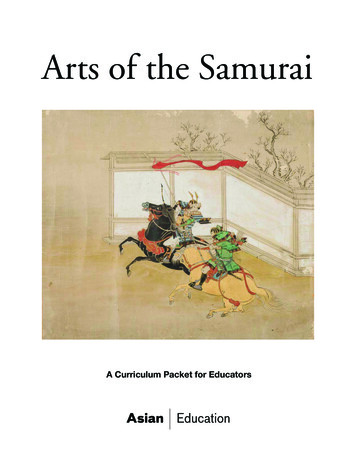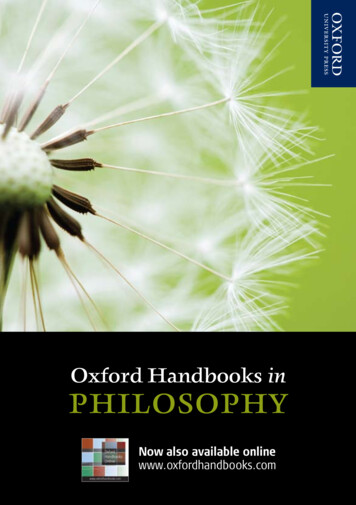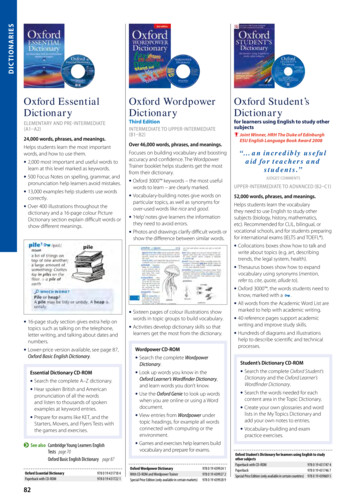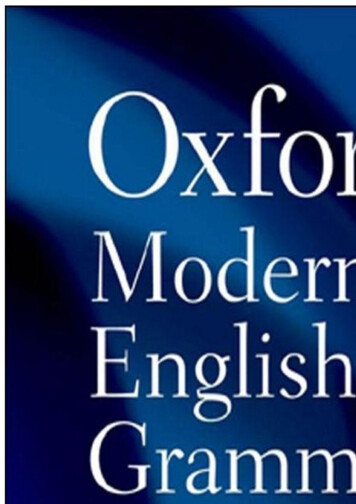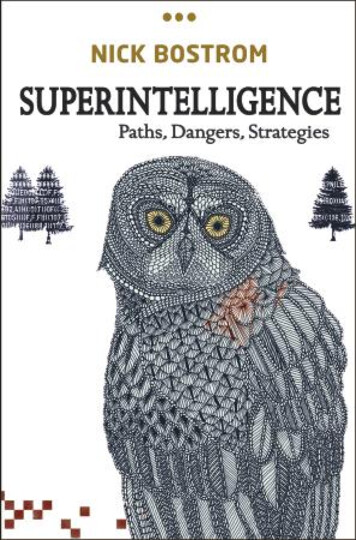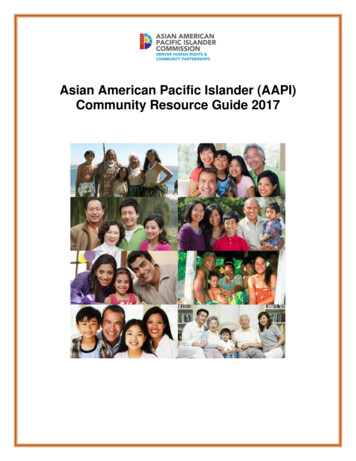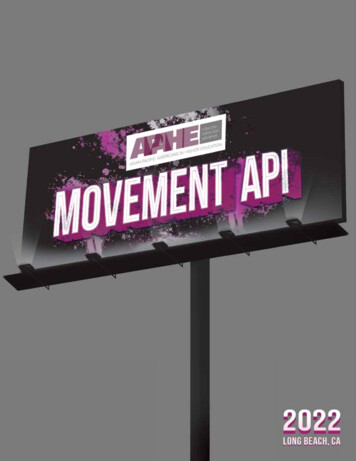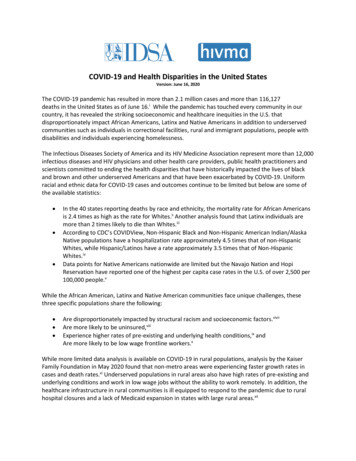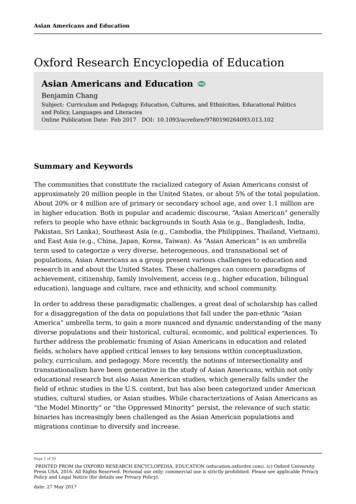
Transcription
Asian Americans and EducationOxford Research Encyclopedia of EducationAsian Americans and EducationBenjamin ChangSubject: Curriculum and Pedagogy, Education, Cultures, and Ethnicities, Educational Politicsand Policy, Languages and LiteraciesOnline Publication Date: Feb 2017 DOI: 10.1093/acrefore/9780190264093.013.102Summary and KeywordsThe communities that constitute the racialized category of Asian Americans consist ofapproximately 20 million people in the United States, or about 5% of the total population.About 20% or 4 million are of primary or secondary school age, and over 1.1 million arein higher education. Both in popular and academic discourse, “Asian American” generallyrefers to people who have ethnic backgrounds in South Asia (e.g., Bangladesh, India,Pakistan, Sri Lanka), Southeast Asia (e.g., Cambodia, the Philippines, Thailand, Vietnam),and East Asia (e.g., China, Japan, Korea, Taiwan). As “Asian American” is an umbrellaterm used to categorize a very diverse, heterogeneous, and transnational set ofpopulations, Asian Americans as a group present various challenges to education andresearch in and about the United States. These challenges can concern paradigms ofachievement, citizenship, family involvement, access (e.g., higher education, bilingualeducation), language and culture, race and ethnicity, and school community.In order to address these paradigmatic challenges, a great deal of scholarship has calledfor a disaggregation of the data on populations that fall under the pan-ethnic “AsianAmerica” umbrella term, to gain a more nuanced and dynamic understanding of the manydiverse populations and their historical, cultural, economic, and political experiences. Tofurther address the problematic framing of Asian Americans in education and relatedfields, scholars have applied critical lenses to key tensions within conceptualization,policy, curriculum, and pedagogy. More recently, the notions of intersectionality andtransnationalism have been generative in the study of Asian Americans, within not onlyeducational research but also Asian American studies, which generally falls under thefield of ethnic studies in the U.S. context, but has also been categorized under Americanstudies, cultural studies, or Asian studies. While characterizations of Asian Americans as“the Model Minority” or “the Oppressed Minority” persist, the relevance of such staticbinaries has increasingly been challenged as the Asian American populations andmigrations continue to diversify and increase.Page 1 of 39PRINTED FROM the OXFORD RESEARCH ENCYCLOPEDIA, EDUCATION (education.oxfordre.com). (c) Oxford UniversityPress USA, 2016. All Rights Reserved. Personal use only; commercial use is strictly prohibited. Please see applicable PrivacyPolicy and Legal Notice (for details see Privacy Policy).date: 27 May 2017
Asian Americans and EducationKeywords: Asian American, methodology, policy, pedagogy, race, ethnicity, intersectionality, transnationalism,literature reviewIntroductionThe 21st century has been labeled by some as “The Asian Century,” which anticipates therise of Asian nations in economic, cultural, and political dominance. Indeed the People’sRepublic of China has already evolved into one of the world’s superpowers, with amassive amount of access, migration, and investment into U.S. markets and otherinstitutions, including the education sector. As various forms of capital and peoplecontinue to flow into the United States, Asian Americans have usually claimed thedesignation of fastest-growing racial group in the United States (Paik, Kula, Saito,Rahman, & Witenstein, 2014). This can be indicated by the U.S. Census’s statistics of 1.5million Asian Americans in 1970, 7 million in 1990, and 19.4 million in 2013. With thesenumbers, and a significant presence in areas ranging from pop culture to politics, and ecommerce to education, Asian Americans are receiving considerable attention in popularand academic discourse. Yet despite this growth and visibility, there is a significantamount of tension and disparity in and across the groups that fall under the monolithicterm of “Asian American.”Within the sociopolitical landscape of the United States and its racialization of ethnicgroups, there are generally five racialized groups: Latina/o, Black, white, Asian, andindigenous peoples (Omi & Winant, 1994). While there are different nomenclatures (e.g.,African American, Caucasian, Hispanic, Oriental, Native American), subgroups, andcontroversies associated with these racializations, they play a significant role in theongoing general discourse of the United States. As with the other racialized groups,“Asian American” is an umbrella category composed of vast and diverse peoples.Although immigrants from Asia have been present in what is now the United States forover 300 years (Cordova, 1983), they did not arrive in larger numbers until the mid-1800s.Since that time, ebbs and flows of Asian immigration have been related to factors such ascolonization, imperialism, globalization, and political economy. Within the popular,academic, and governmental discourse in North America, there are several subgroupsfrom different parts of Asia that are considered Asian American. These include those thatare referred to as being from South Asia (e.g., Bangladesh, India, Nepal, Pakistan, SriLanka), Southeast Asia (e.g., Cambodia, Indonesia, Laos, Philippines, Thailand, Vietnam),and East Asia (e.g., China, Japan, Korea, Taiwan). In some instances, peoples from thePacific Islands (e.g., Guam, Hawaii, Samoa) or West Asia (e.g., Iran, Iraq), are includedunder the even broader umbrella term Asian Pacific Islander (API) or Asian AmericanPacific Islander (AAPI). In addition, to distinguish the presence and experiences of SouthAsians (sometimes referred to as “Desis”), the term “Asian Pacific Islander DesiAmerican” (APIDA) has also been utilized in recent years (S. Shankar, 2011). Here, “AsianAmerican” will refer to those of South, Southeast, and East Asian background living inPage 2 of 39PRINTED FROM the OXFORD RESEARCH ENCYCLOPEDIA, EDUCATION (education.oxfordre.com). (c) Oxford UniversityPress USA, 2016. All Rights Reserved. Personal use only; commercial use is strictly prohibited. Please see applicable PrivacyPolicy and Legal Notice (for details see Privacy Policy).date: 27 May 2017
Asian Americans and Educationthe United States, which aligns with the U.S. Census. Although they share some commonexperiences, Pacific Islanders are not grouped together with Asians here, given thedistinct histories and conditions of indigenous peoples from the Pacific Islands, which areusually quite disparate from Asian peoples, including those who migrated to and settledin the same Pacific Islands (B. Chang & Au, 2008; Labrador & Wright, 2011).Key demographic features of the Asian American community with regards to educationwill be discussed. The demographics discussion will be used as a springboard for lookingat the naming and typologies of the diverse communities considered to be a part of “AsianAmerica.” Several key tensions within the realm of education with Asian American groupswill be examined, particularly around conceptualizations, policy, and pedagogy related toeducational equity. This focus on conceptualizations and equity is informed by critical andintersectional scholarship that critiques some of the existing paradigms of research onAsian Americans and education that tend to frame the scholarship through a straight lineof historical progress, or a one-by-one analysis of each ethnic subgroup. Suggestions arepresented on generative areas of research and pedagogy to address key themes andtensions raised.Page 3 of 39PRINTED FROM the OXFORD RESEARCH ENCYCLOPEDIA, EDUCATION (education.oxfordre.com). (c) Oxford UniversityPress USA, 2016. All Rights Reserved. Personal use only; commercial use is strictly prohibited. Please see applicable PrivacyPolicy and Legal Notice (for details see Privacy Policy).date: 27 May 2017
Asian Americans and EducationDemographics and Naming of Asian AmericaKey DemographicsSome of the years of the sources of the demographic information pertinent to issues ofAsian Americans and education vary, as not all relevant statistical information is collectedor available each year, such as with the U.S. Census taken every 10 years, or theAmerican Community Survey (ACS), which is conducted annually but with limited areasof data. In some instances, data from before 2010 are cited, but these are usually in thecontext of an academic article that names trends still pertinent to the conditions ofeducation emphasized. Aside from providing a quantitative snapshot of Asian Americans,the data also serve to illustrate how diverse and disparate “Asian American” subgroupscan be. The data point to the urgent need of clearly and consistently disaggregating dataon Asian Americans in an effort to debunk flawed and stereotypical discourse foundacross scholarship, policies, and pedagogy.According to the 2013 ACS, approximately 19.4 million of the United States’ total 320million residents were categorized as Asian American (U.S. Census Bureau, 2013A). The sixlargest Asian American ethnic subgroups were those who indicated they were of thefollowing descent: Chinese (4.3 million, not including Taiwanese), Filipina/o (3.6 million),Asian Indian (3.5 million), Vietnamese (1.9 million), Korean (1.8 million), and Japanese(1.4 million). Other large subgroups included Pakistani (409,000), Cambodian (276,000),Hmong (260,000), Thai (237,000), Laotian (232,000), Taiwanese (230,000), Bangladeshi(147,000), and Burmese (100,000). Of the 19.4 million who indicated they were AsianAmerican, the number includes those who stated they were at least partly of Asianheritage from one or more of 24 possible ethnic groups subsumed under the AsianAmerican umbrella. In addition, the Census reported that more than 15% of AsianAmericans indicated they were of “mixed race” heritage (U.S. Census Bureau, 2012), alsoknown as “Hapa” in some contexts. More than 60% were born outside of the UnitedStates, the largest of any racialized group.The 10 states with the largest Asian American populations, and their approximatenumber as of the 2013 ACS, were California (6.1 million), New York (1.8 million), Texas(809,000), New Jersey (743,400), Illinois (592,000), Florida (547,000), Hawaii (531,000),Washington (516,300), Massachusetts (455,000), and Pennsylvania (358,000). Somethree-quarters of Asian Americans reported living in urban areas, and the 10 highestconcentrations of Asian Americans were living, respectively, in the general metro areas ofLos Angeles–Orange County (about 1.9 million); New York–New Jersey; San Francisco–Oakland; San Jose; Chicago; Washington, D.C.; Honolulu; Seattle-Tacoma; Houston; andDallas–Fort Worth (about 342,000). In popular discourse, using the term “urban areas”populated by Asian Americans may stir the image of low-income ethnic enclaves likePage 4 of 39PRINTED FROM the OXFORD RESEARCH ENCYCLOPEDIA, EDUCATION (education.oxfordre.com). (c) Oxford UniversityPress USA, 2016. All Rights Reserved. Personal use only; commercial use is strictly prohibited. Please see applicable PrivacyPolicy and Legal Notice (for details see Privacy Policy).date: 27 May 2017
Asian Americans and Educationinner-city Chinatowns; however; there are also large numbers living in suburbs of themetro areas just listed (J. S. Lai, 2011; Saito, 1998).The median age of Asian Americans was 36.3, with the national median at 37.5; 21.1%were under the age of 18, while 10% were 65 or older (U.S. Census Bureau, 2013B).Linguistically, over 71% of Asian Americans over the age of five speak a language otherthan English at home. The 2013 ACS shows that the Census categorizes languages in oneof four groups, namely Spanish, Other Indo-European Languages, Asian and Pacific IslandLanguages, and All Other Languages. This creates something of an issue when extractingparticular language data for Asian Americans, as Hindi, Gujarati, Punjabi, and Urdu areseparated from Asian and Pacific Island Languages. Nevertheless, some statistics can bedetermined, including the following on languages most frequently used in households:Chinese (2.38 million, not disaggregated for dialect), Tagalog (1.44 million), Vietnamese(1.2 million), Korean (1.04 million), Hindi (527,000), Japanese (458,000), Urdu (326,000),Gujarati (304,000), Punjabi (210,000), Bengali (188,000), Mon-Khmer or Cambodian(185,000), Hmong (182,000), Telugu (171,000), Laotian (148,000), Thai (142,000), Tamil(133,000), Malayalam (117,000), Formosan (76,800), Ilocano (75,000), and Indonesian(58,000).One Asian American demographic that is rather under-researched is sexual orientationand gender (Kumashiro, 1999; Ocampo & Soodjinda, 2016). While national data are notwidely available, the first of such large-scale studies looked at over 860 participants from38 states, with the sample’s geographic representation matching the nationaldemographic of Asian Americans in general (Dang & Vianney, 2007). Among the study’sparticipants, 10% identified as transgender, 41% as women, and 53% as men.Participants who indicated woman or man and one of the transgender identities weretabulated in both categories. Of the participants, 9% self-identified as bisexual, 19% aslesbian, 20% as queer, and 47% as gay, with women being more than twice as likely asmen to identify as queer. Some 75% of participants reported being discriminated againstfor their sexual orientation, and 86% reported racial or ethnic discrimination.For the 2013 ACS, the median income for Asian American households was 72,400, whilethe U.S. median was 51,900. It should be noted that this seemingly higher median forAsian Americans may be misleading, as Asian American households tend to have moremembers than the median. It should also be noted that there are wide disparities acrosssubgroups, including in areas such as ethnicity and class or socioeconomic status (E. Lai& Arguelles, 2003). For example, in 2013 the median income for Asian Indian householdswas 100,500, while it was 51,300 for Bangladeshi homes, thus indicating high disparitywithin the Asian American umbrella, and the South Asian subgroup. The poverty rate forAsian Americans was 12.7%, compared to a national median of 14.5%. Again, however,statistics tell a different story when disaggregated for ethnic groups. For example, 15.4%of Cambodian Americans reported living in poverty in the United States, with a rate of28% in New York City (CAAAV, 2011).Page 5 of 39PRINTED FROM the OXFORD RESEARCH ENCYCLOPEDIA, EDUCATION (education.oxfordre.com). (c) Oxford UniversityPress USA, 2016. All Rights Reserved. Personal use only; commercial use is strictly prohibited. Please see applicable PrivacyPolicy and Legal Notice (for details see Privacy Policy).date: 27 May 2017
Asian Americans and EducationRegarding primary and secondary schools, there are approximately 2.56 million AsianAmerican students in attendance, or about 4% of the total number of K–12 students in the2013 ACS. There are about 28,000 Asian American teachers, which is around 1% of theU.S. teaching force, although the number of Asian American teachers continues todecrease, similar to other communities of color (Philip, 2012; Rong & Preissle, 1997). Some86.6% of the U.S. population over 25-years-old were indicated as having a high schooldiploma, with Asian Americans slightly less at 86.2%. However, there were significantdisparities across ethnic groups, with over 94% of Taiwanese and Japanese Americanshaving a high school degree, while Laotian and Hmong Americans were under 66%.Language use and needs in education are a bit challenging to determine, as the data arecategorized inconsistently. For example, the 2009 National English Language LearnerStatus data do not distinguish between Asians and Pacific Islanders (National Center forEducation Statistics, 2009). Thus, the statistic that holds that 16% of Asian and PacificIslander Americans are English language learners and should therefore be receivingsupport in schools, although appropriate support has long appeared to be an issue (Olsen,1997;Redondo, 2008). Appropriate support also appears to be an issue in terms of AsianAmerican special needs students. Similar to many Latina/o and Black students,mislabeling of Asian American students as “special needs” can occur when the issues aremore related to language, poverty, racism, parent involvement, inappropriate support,and other factors (J. M. Chang & Liu, 1998; Poon-McBrayer, 2011). As with the two largercommunities of color in the United States, Asian American males are much more likely tobe placed in special education (over 70%), than females. However, unlike Latina/o andBlack student communities, Asian Americans are underrepresented in special education(Lo, 2008), which seems to be more about underreporting than the fulfillment of the ModelMinority stereotype of Asian Americans. Some statistics show that Chinese, Indian,Korean, and Vietnamese students make up the majority of Asian Americans in specialeducation (Doan, 2006). However, other than Filipina/os, it should be noted that thosegroups are also the largest Asian American ethnic subgroups, which may affect thefindings.Levels of education have been discussed by many as a reason to support the discoursearound Asian Americans as the Model Minority in some form (Center, 2013; Covarrubias &Liou, 2014). ACS 2013 data show that 21.6% of Asian Americans 25 and older had amaster’s degree or higher, and 51.3% had a bachelor’s degree or higher. These statisticsare notable considering the respective national averages of 11.2% and 29.6%. In terms ofattendance at higher education institutions, Asian Americans have been portrayed as“taking over” university campuses (M. J. Chang, 2008; Teranishi, 2010), especially at eliteinstitutions. In reality, the increases in total higher education attendance mirror those ofother racialized groups between 1987 and 2004, with 1.1 million Asian Americans, 1.8Latina/os, and 2.2 African Americans (CARE, 2008). The same data show some two-thirdsof Asian Americans concentrated at 200 campuses in eight states, with the majority beingat public institutions, and an even distribution across four-year and the generally openenrollment two-year schools. For fields of study, despite the stereotype of AsianPage 6 of 39PRINTED FROM the OXFORD RESEARCH ENCYCLOPEDIA, EDUCATION (education.oxfordre.com). (c) Oxford UniversityPress USA, 2016. All Rights Reserved. Personal use only; commercial use is strictly prohibited. Please see applicable PrivacyPolicy and Legal Notice (for details see Privacy Policy).date: 27 May 2017
Asian Americans and EducationAmericans focusing on STEM (science, technology, engineering, and mathematics)subjects, there were about 29% majors in business, 26% in social science and humanities,22% in engineering, 14% in education, and 9% in health or life sciences.When looking across education data in general on the Asian American umbrella group, itcan be observed that the numbers tell a different story than that of the Model Minoritythat is often narrated in the popular discourse. When disaggregated across class,ethnicity, immigration, and other categories, the numbers present much more complexnarratives. Indeed, a clarion call across scholarship on Asian Americans and education isthe disaggregation of Asian American groups, toward better understanding andaddressing the issues and moving toward greater educational equity (Ng, Lee, & Pak,2007).Although there has been relatively little discussion of inter-group differences in thepopular media since the “Model Minority” was coined in 1966 (Wang, 2008), anassemblage of tensions and disparities between Asian American subgroups has beenaddressed for several decades in fields such as ethnic, cultural, and Asian Americanstudies, as well as spaces of political organizations and community groups (Ali, 2016; Chin,1971;Omatsu, 1986; A. Ong, 1995).History and Politics of NamingAlthough Asian American is the official term of the U.S. Census, there are numerous waysAsian Americans are referred to within education and related areas like social services,NGOs, and community agencies and scholarship that addresses Asian Americanpopulations, like cultural studies, ethnic studies, and Asian American studies. A partiallist of names used would include Asian, Asian American, Asian Pacific American (APA),Asian Pacific Islander American (APIA), and Asian Pacific Islander Desi American(APIDA), with other variations that call for the removal of “American” at the end of theterm, or the inclusion or exclusion of hyphens (e.g., Asian Pacific Islander, AsianAmerican). The term Asian American was actually not used widely until the late 1960s.During the preceding 100 years, as the total Asian population came to number in thethousands, Asian groups were framed more by their nationalities (e.g., Japanese,Filipino), and were racialized differently (e.g., Chinese as Mongol, Indian as Aryan orCaucasian) (Prashad, 2000; Takaki, 1998). These disparities were often tied to the UnitedStates’ engagements with foreign Asian nation-states such as in the Philippine AmericanWar (1899–1902), as well as in domestic experiences within the United States like theChinese Exclusion Act (1882) and the mass incarceration of Japanese Americans (WorldWar II). Other factors that served to divide Asian groups in the United States were linkedto histories between their home nation-states, such as Japanese imperialism in China,Korea, and the Philippines, and the multiple divisions of the Indian subcontinent intoPakistan, Bangladesh, India, and other states.Page 7 of 39PRINTED FROM the OXFORD RESEARCH ENCYCLOPEDIA, EDUCATION (education.oxfordre.com). (c) Oxford UniversityPress USA, 2016. All Rights Reserved. Personal use only; commercial use is strictly prohibited. Please see applicable PrivacyPolicy and Legal Notice (for details see Privacy Policy).date: 27 May 2017
Asian Americans and EducationMoving Toward the “Asian American” UmbrellaBy the late 1960s, the conceptualization of Asian Americans as a group was catalyzed byseveral factors, including U.S. wars with Korea and Vietnam, the civil rights movement,the 1965 Immigration and Nationality Act, and Third World liberation movements aroundthe world by peoples of color against their colonial rulers (Kochiyama, 2004; Liu, Geron, &Lai, 2008). More specifically, these developments helped consolidate an Asian Americanidentity through framing Asians as the enemy in war, categorizing Asians as a U.S.minority group (along with blacks, Latina/os, and American Indians), enablingunprecedented numbers of educated and middle-class Asians and their families toimmigrate into the country, and challenging the notion of whites as the saviors andleaders of peoples of color. These domestic and international factors helped to pushdiverse Asian populations together in the United States, even if they did not seethemselves in the same light. Although the umbrella term and identity of “AsianAmerican” began to be used more widely during the late 1960s, it was not yet thecommon term, as it was associated more with radical politics and activism. Popularlyattributed to Japanese American scholar-activist Yuji Ichioka (Leong, 2002), the term “AsianAmerican” was an identity of resistance that challenged the framing of Asian peoples asthe Oriental, the binary opposite to white and European peoples as the Occidental. In thisgrand narrative of history and civilization, Orientals were the exotic, the uncouth, the“Yellow Peril,” and “The Other,” while Occidentals were the civilized, the beautiful, theintelligent, the enlightened, and the standard (A. M. Y. Lin, 2012; Luke, 2009). Given thisnarrative, whether white Americans were in the role of missionary, statesman,entrepreneur, soldier, or teacher, the duty was to “save the Asian races,” as almost anextension of the “Go West” and Manifest Destiny ideology (Palumbo-Liu, 1999; Pascoe, 1990).As a challenge to these notions of a white supremacy, Asian activists in the United Statesduring the 1960s saw the Asian American identity as one that aligned itself with otherpeoples of color in the United States and Third World peoples abroad, who sought tochallenge white hegemony and its teachings and preachings of “minorities” having toreject their sociocultural backgrounds in order to assimilate toward whiteness (Aguirre &Lio, 2008). These notions were directly connected to the Third World liberation movementsin the United States (e.g., American Indian Movement, Asian American Movement) andtheir related calls for community-based ethnic studies (e.g., black studies, AsianAmerican studies) that caught international attention in 1968 (J. P. Chan et al., 2009;Maeda, 2009).Since the late 1960s, “Asian American” has come to be widely used and institutionalized.While some factors that urged Asians to the pan-ethnic term have significantly changed,it continues as a salient term and grouping. In studying the propagation of AsianAmerican pan-ethnicity during the 1970s and 1980s, Espiritu cited culture, emotion,economy, and politics as major factors, with examples including anti-Asian violence,electoral representation, and social service funding (1992). This development of the AsianAmerican pan-ethnic identity has brought substantial benefits to communities affiliatedwith it, including greater socioeconomic and political clout (Geron, de la Cruz, Saito, &Singh, 2001; D. G. Okamoto, 2006). Yet despite such factors that provide the impetus forPage 8 of 39PRINTED FROM the OXFORD RESEARCH ENCYCLOPEDIA, EDUCATION (education.oxfordre.com). (c) Oxford UniversityPress USA, 2016. All Rights Reserved. Personal use only; commercial use is strictly prohibited. Please see applicable PrivacyPolicy and Legal Notice (for details see Privacy Policy).date: 27 May 2017
Asian Americans and EducationAsians to come together and identify under the umbrella, there are also numerous factorsthat disrupt it. The historical divisions between Asian groups and their nation-states havealready been alluded to, such as Japan’s imperialism and wartime atrocities across Asia.Another example of historical nation-state divisions that are still relevant is the diversityof groups in Taiwan, such as the aboriginals, the Chinese who lived in Taiwan for manygenerations, the more recent Chinese who fled their country’s civil war to Taiwan, andthe Nationalist Party elite who also fled mainland China but took control of Taiwan in the1940s. While many of those who can trace their aboriginal ancestry do not come to theUnited States, members of the other three groups have been doing so for decades. Interms of education, the identities, practices, and schooling pathways of TaiwaneseAmerican students can be highly correlated to which groups in Taiwan their familiescame from, such as the Nationalist Party elite or the engineers and doctoral students whocame to the United States via the 1965 Immigration Act (Glenn & Yap, 2000; Louie, 2004).The children of such families enter the U.S. educational system with significant amountsof economic, social, and cultural capital whether they are first generation (born outside ofthe United States) or second generation (born in the United States to immigrant parents).These types of students are often spotlighted in support of the high-achieving ModelMinority Myth (MMM) of Asian Americans (S. J. Lee, 2009). Contrary to the MMM, studentsof working-class Taiwanese origin that are 1.5 generation (those who immigrate at ayoung age) may not have the capital of the aforementioned groups, and may engage inself-defeating forms of resistance whether in Queens, New York, or the San Gabriel Valleyin Los Angeles (B. Chang, 2015A; Ta, 2005). Despite the significant differences inbackgrounds and pathways of these groups of students, their diversity may be maskedwhen lumped together as Taiwanese Americans, or perhaps Chinese Americans morebroadly and Asian Americans in general.Page 9 of 39PRINTED FROM the OXFORD RESEARCH ENCYCLOPEDIA, EDUCATION (education.oxfordre.com). (c) Oxford UniversityPress USA, 2016. All Rights Reserved. Personal use only; commercial use is strictly prohibited. Please see applicable PrivacyPolicy and Legal Notice (for details see Privacy Policy).date: 27 May 2017
Asian Americans and EducationFurther Disruptions under the UmbrellaAside from longstanding historical divisions related to the nation-states that differentAsian Americans come from, there are also developments within the United States thatserve to disrupt the unitary identity and construct of Asian America. One development isthe predominance of East Asians over South and Southeast Asians within the popular andacademic discourse, which may largely omit South Asians from the discussion (L. D.Shankar & Srikanth, 1998). An instance of this is when a characteristic can be foundsomewhat applicable to Chinese, Japanese, or Korean Americans (e.g., Confucianisminspired practices), it is portrayed as the norm for all other Asian Americans despite theirimmense differences. A specific example can be found with students of Korean heritage.While behaviors and interventions summarily assigned to all Korean American students,teachers, and families is problematic within itself (Lew, 2007), it presents an even largerissue when applied to other Asian Americans. What makes this issue more complex inaddressing is the reification of these problematic tropes by some Asian Americans ontothe rest of the umbrella group’s communities. A pop culture example includes viral videoson YouTube about things “Asian Americans” supposedly do, created by East AsianAmericans (Bros, 2013). In educational scholarship we may not see such blatantgeneralizations, but at times publications with titles and keywords that denote “AsianAmerican” may be more about specific groups, most commonly East A
for a disaggregation of the data on populations that fall under the pan-ethnic "Asian America" umbrella term, to gain a more nuanced and dynamic understanding of the many diverse populations and their historical, cultural, economic, and political experiences. To further address the problematic framing of Asian Americans in education and related
